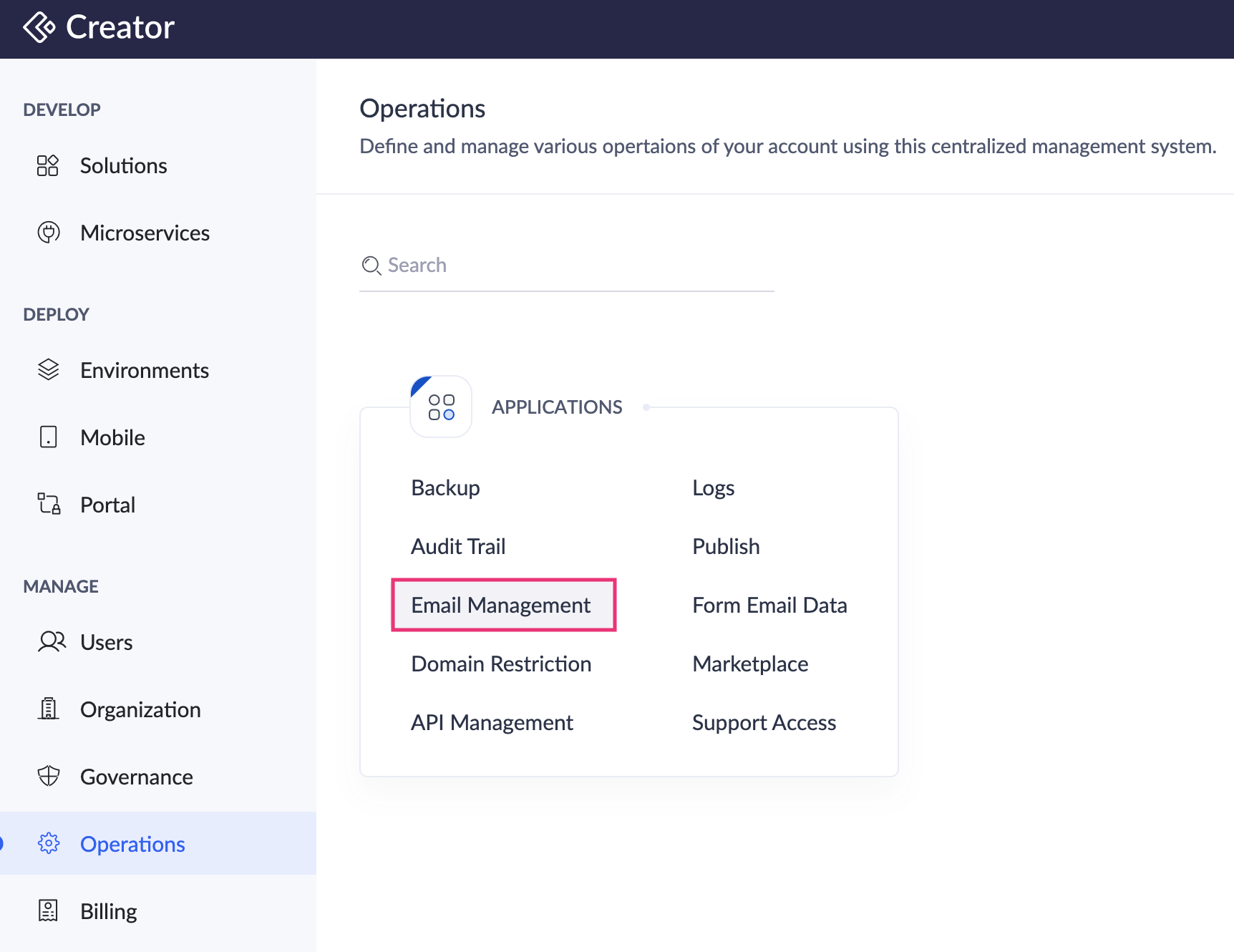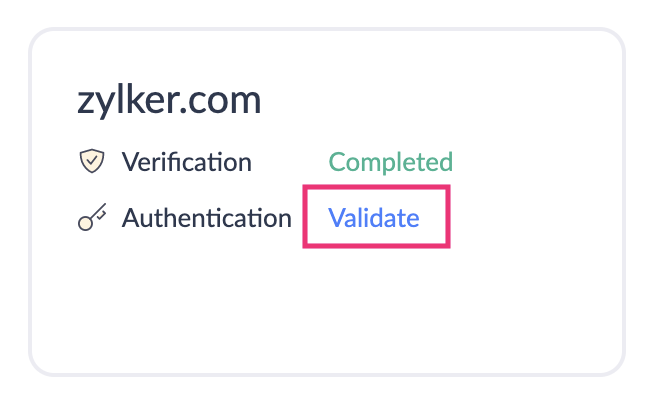Manage domains in your Zoho Creator account


The domain authentication process has two steps, which are listed below. You can also delete a domain.
Verifying a domain in Zoho Creator
Your domain is directly verified at the time of sender email verification. Once the sender email is verified, the domain's Verification status is marked as Completed in the Domain Authentication tab.

Authenticating a verified domain in Zoho Creator:
- Navigate to Operations on the left pane and select Email Management under Applications.

- Click the Domain Authentication tab.
- Click Validate in the domain details card.

- A Domain Authentication popup will appear.

- In the top right corner of the SPK and DKIM records , click the Copy icon. You need to copy SPF and DKIM records from here and paste them into your domain provider's site's DNS settings.
The table below provides the format in which these records must be added to your Domain provider's DNS settings.
From Zoho Creator Description In your domain provider's site SPF Sender Policy Framework
When you send an email using you@yourdomain.com from Zoho Creator, the recipient servers refer the SPF records to check if the email sent from Zoho Creator is genuine.
Some email servers reject the emails if there is a mismatch or if there are no valid SPF records for your domain.
Generally, you can publish the SPF records as TXT records in the DNS Providers (Domain Registrars/ DNS Managers).
SPF records need to be pasted as follows:
v=spf1 include:usermail.zohocreator.com ~allFor Multiple SPF records:
Multiple SPF records are not considered valid.If you need to use multiple email servers for your domain, you can update the details in the same SPF record instead of multiple entries.
Update the SPF record with:
include:usermail.zohocreator.com
DKIM Domain Keys Identified Mail
DKIM is an authentication method that uses encryption with public and private keys, to validate whether emails are generated from the authorized servers, and are recognized and configured by the administrators of the sending domains.
If DKIM is configured, the domain name identifier associated with each message is validated.
If this DKIM validation fails, such emails are quarantined or rejected based on the conditions set by you when DKIM validation fails
DKIM records need to be pasted as provided below:
- Copy the unique public DKIM Key generated in Zoho Creator.
- Paste it in your Domain's DNS Manager (Domain registrar/ DNS Provider).
- Click Validate after pasting the SPF and DKIM records in your domain provider's site. The DNS changes will be immediately updated and the Domain's Authentication status will change to Completed . The Status will be set as Active.
To deactivate a domain

- Toggle the Active/Inactive button in the required domain's card to deactivate it.
- To activate a domain again, toggle the Active/Inactive button.
To delete a domain

- Deleting a domain will only remove the authentication done. The domain will still be listed.
- To completely remove a domain from the listing, all verified emails belonging to that domain must be deleted.
- Hover over the required domain's card.
- Click on the vertical ellipsis (three-dot) icon present at the top-right corner of the domain's card and click Delete .
- Click the Delete button to confirm the delete request in the popup that appears.

Related Topics
Zoho CRM Training Programs
Learn how to use the best tools for sales force automation and better customer engagement from Zoho's implementation specialists.
Zoho DataPrep Personalized Demo
If you'd like a personalized walk-through of our data preparation tool, please request a demo and we'll be happy to show you how to get the best out of Zoho DataPrep.
You are currently viewing the help pages of Qntrl’s earlier version. Click here to view our latest version—Qntrl 3.0's help articles.
Zoho Sheet Resources
Zoho Forms Resources
Zoho Sign Resources
Zoho TeamInbox Resources
Related Articles
Domains in Zoho Creator
In a nutshell Domains in Zoho Creator (supported by Zoho Directory) allow you to add and verify the custom domains you own. While domain authentication in Creator is primarily used to authenticate sender email addresses, the Domain feature (via Zoho ...FAQs: Governance in Zoho Creator -Supported by Zoho Directory
This page covers essential aspects of Zoho Creator, such as governance, Active Directory sync, multi-factor authentication, custom authentication, security policy, and domain verification, ensuring a secure and efficient business workflow. What is ...Custom authentication in Zoho Creator
This help page is for users in Creator 6. If you are in the older version (Creator 5), click here. Know your Creator version. In a nutshell Custom authentication allows you to authenticate a third-party identity provider to allow your users to use ...Security policies in Zoho Creator
This help page is for users in Creator 6. If you are in the older version (Creator 5), click here. Know your Creator version. In a nutshell Security policies in Zoho Creator (supported by Zoho Directory) lets you improve a user's authorization ...Encryption using Private Key in Zoho Creator
1. In a nutshell Bring Your Own Encryption Key (BYOK) allows you to encrypt your field data using a private key you configure and manage in Zoho Directory. This gives you direct control over your encryption, ensuring compliance with your ...















